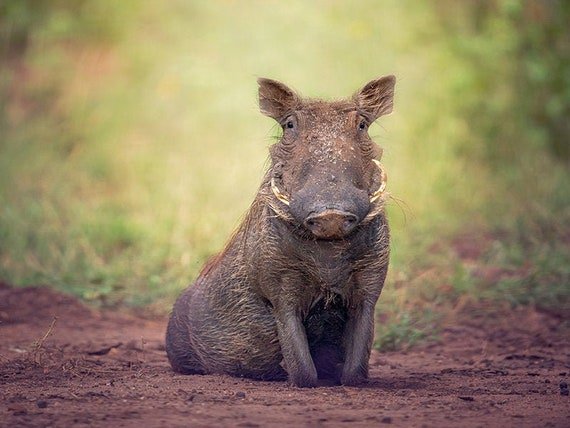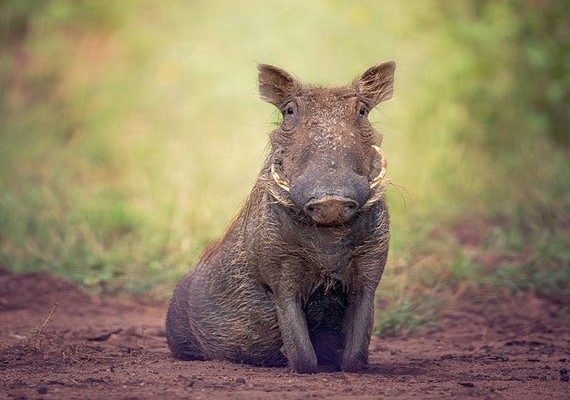
Imagine chatting about your favorite animal while sipping coffee; you might say, “You know, the warthog isn’t just a funny-looking pig! They play a crucial role in their ecosystem.” Here’s the thing: many people don’t realize that even these seemingly common animals can face serious threats. So, let’s dive into whether warthogs are endangered and what’s being done to protect them across the globe.
What is a Warthog?
Warthogs are wild pigs found primarily in Africa. They have a distinct appearance, with large tusks and facial warts, giving them an almost cartoon-like look. Their sturdy, stout bodies are built for speed and agility, allowing them to dart through grasslands and bushy areas.
You might be surprised to learn that warthogs are surprisingly social creatures. They often gather in groups, called sounders, usually made up of females and their young. Males typically roam solo or form small bachelor groups. This social behavior is essential for their survival, as it helps protect them from predators.
When you spot a warthog digging for food, it’s like seeing a child at a playground, fully engaged and having fun. They root around for grasses, roots, and fruits, which makes up a large part of their diet, showing how adaptable they can be in their natural habitat.
Current Conservation Status of Warthogs
So, are warthogs endangered? The good news is that the **IUCN Red List** currently classifies the warthog as a species of “Least Concern.” This means they aren’t facing the immediate threat of extinction, but that doesn’t mean they are out of the woods. Like a balancing act, their population levels depend on various environmental and human factors.
In some regions, warthogs thrive, particularly in protected areas like national parks. However, in places where they face habitat loss or hunting pressures, their numbers can dwindle significantly. This duality highlights the importance of understanding local conservation efforts and how they impact warthog populations.
You might be wondering about the specific threats they face. Let’s break those down in the next section.
Threats to Warthog Populations
Warthogs face several threats, impacting their survival in the wild. Understanding these challenges is crucial if we want to support their conservation. Here are the top threats:
- Habitat Loss: As human populations expand, warthogs lose their natural habitats to agriculture and urban development. This change can limit their access to food and water.
- Poaching: In some areas, warthogs are hunted for their meat and tusks, which decreases their populations.
- Human-Wildlife Conflict: As warthogs wander into human settlements, they may cause damage to crops, leading to retaliatory killing from farmers.
- Climate Change: Changes in climate patterns can affect their food supply and the availability of suitable habitats.
Each of these threats connects to broader environmental issues that affect many wildlife species. It’s like a domino effect—when one problem arises, it can create a chain reaction that impacts others in the ecosystem.
Global Conservation Efforts
To tackle these threats, various conservation efforts are underway worldwide. Organizations and governments are teaming up, focusing on habitat protection and sustainable practices. Here are a few key strategies being implemented:
- Protected Areas: Establishing national parks and wildlife reserves helps safeguard habitats where warthogs can thrive without human interference.
- Community Education: Educating local communities about the importance of preserving warthogs and their habitats can reduce human-wildlife conflict.
- Anti-Poaching Initiatives: Strengthening anti-poaching laws and monitoring populations helps combat illegal hunting.
- Research and Monitoring: Ongoing studies on warthog behaviors and population dynamics provide valuable data to inform conservation strategies.
Each of these approaches highlights how important it is for communities, organizations, and governments to work together to ensure the future of warthogs.
The Role of Local Communities
Local communities play a significant role in conserving warthogs and their ecosystems. With traditional knowledge about wildlife and land, these communities often have valuable insights that can improve conservation strategies.
For example, involving local farmers in conservation efforts can lead to innovative solutions that allow warthogs and agricultural activities to coexist. It’s like finding a way for neighbors to resolve their differences amicably—both sides benefit.
Community-based initiatives can build a sense of ownership and investment in local wildlife. When people see the value in protecting warthogs, they’re more likely to take action to ensure their survival. Programs that highlight eco-tourism can also provide economic incentives, showing that preserving wildlife can be both profitable and beneficial for the environment.
How You Can Help
You might be thinking, “That’s great, but what can I do to help warthogs?” Even if you’re far from their habitats, there are ways to contribute. Here are a few suggestions:
- Support Conservation Organizations: Donate to or volunteer with organizations that work directly on warthog conservation.
- Spread Awareness: Share information about warthogs on social media to educate others about their status and the importance of conservation.
- Choose Sustainable Products: Opt for products that don’t harm wildlife habitats, supporting businesses that prioritize sustainability.
- Visit National Parks: If you have the opportunity, go on a safari or visit wildlife reserves. Your tourism dollars can help local economies and conservation efforts.
Every little bit helps. Think of it like watering a plant. Each drop counts toward helping it grow and thrive.
In summary, while **warthogs** are currently classified as a species of “Least Concern,” they’re not out of danger yet. Continued habitat loss, poaching, and climate change present ongoing challenges. The global conservation efforts and local community involvement are crucial for their survival, reminding us that each of us can play a part in their story.
As we learn more about these remarkable animals and their struggles, we can advocate for their protection and help ensure they remain a vibrant part of our world. When we think about warthogs, it’s not just about their quirky appearance; it’s about fostering a future where they can thrive in their natural habitats. So, let’s join hands in this mission and make a difference—one warthog at a time!

